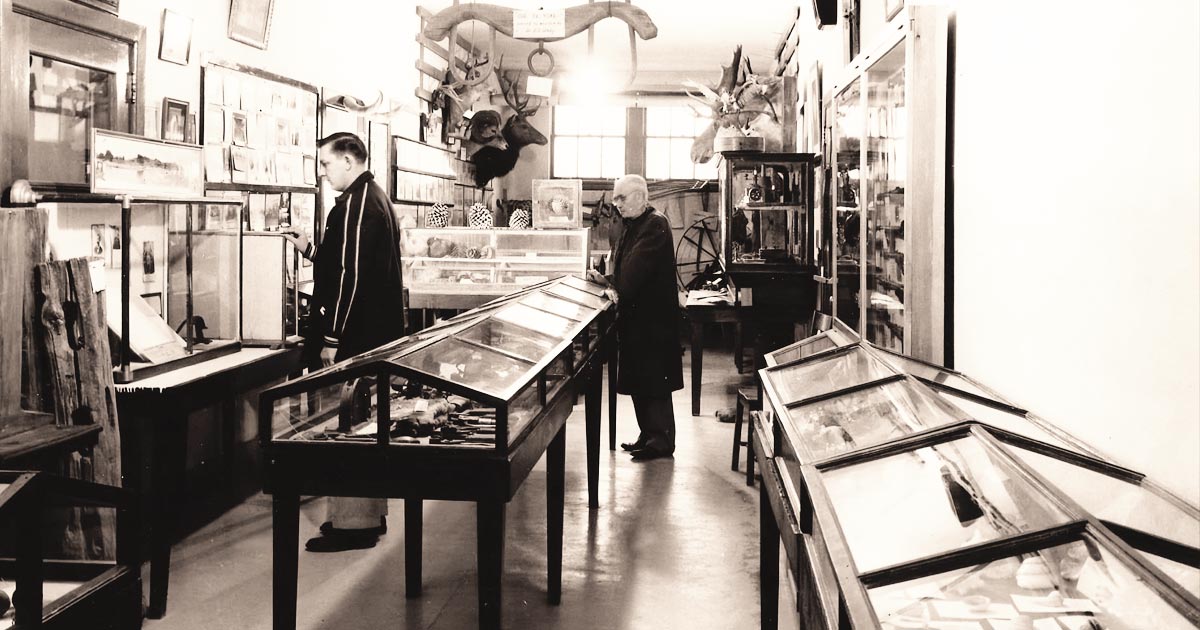Montana has a well-deserved reputation for spectacular dinosaur fossils. The very first dinosaur remains were found near Judith Landing in 1854 in what is now the Missouri Breaks National Monument. The first Tyrannosaurus rex was discovered in the Hell Creek area near Jordan in 1902 by paleontologist Barnum Brown, who worked for the American Museum of Natural History. Early fossils discovered often ended up in the Smithsonian, the American Museum and the Peabody Museum, all well known and generously endowed museums. But local ranchers in 1936 had other ideas about the fossils.
The original group, called the Carter County Geological Society, made up mostly of ranchers and their friends, was founded to collect and study dinosaur fossils and to store and exhibit them locally in the tiny town of Ekalaka. Two members, Walter Peck and Idela Kennedy, helped make the dream of a local museum come true. Peck was a member of the Montana State Senate who helped pass legislation to fund county museums through local taxes.
The Carter County Museum was the first to be established in the state. Idela Kennedy was a local teacher who cataloged and organized the fossils, ensuring their provenance would not be lost, an important function of museums.
The group of ranchers worked with the local school Superintendent to establish the first museum in the basement of the first high school in Ekalaka. When the county built a new high school years later, the museum took up the whole first floor. Finally, in the 1980s, the museum got its own stand-alone building. Today, the Carter County Museum is nationally and internationally known for its amazing collection of dinosaur fossils.
“Our collection provides 100 million years of history through the fossils collected by ranchers, hikers, and local kids,” says Sabre Moore, the museum’s executive director. “The museum has fossils of plants, reptiles, birds, and shells of ammonites as well.”
In 2013 the museum established an advisory council to help them refine and improve their educational outreach, an important part of the museum’s focus.
“We really want to be a resource for students in our community,” Moore says. “A math, science, and elementary teacher are on the council to help us. We want to be responsive to whatever the community wants to learn.”
A not-to-be-missed yearly event is the annual Dino Shindig, held July 22-23 this year. The museum develops a list of excellent speakers, which changes each summer.
“This year there will be 14 speakers on a wide-range of topics from asteroid impacts, prehistoric mammals, to how early life might have started on Earth,” says Moore.
The evening features a street dance which pauses briefly for folks to take part in a Fish and Wildlife guided bat walk, complete with iPads to identify species.
“The bat walk doesn’t take too long, and people of all ages love it,” Moore says. “Then, once that’s over, it’s back to the fun street dance.”
On Sunday, folks lucky enough to have snagged a ticket are taken to an area being actively searched to actually dig for fossils.
“We publicize the dig in January, and this year all 60 spots were gone in four hours,” says Moore. “But people who don’t get a ticket are still taken to a micro site at nearby Medicine Rocks State Park.”
Medicine Rocks State Park works closely with the Carter County Museum to enhance the community’s knowledge of nature and to attract visitors.
“The museum acts as an unofficial visitor center for the state park,” Moore says. “We include the park in our Dino Shindig and in other ways throughout the summer.”
In 2020, Medicine Rocks State Park was nominated to be part of the Dark Sky Places Association. These special areas provide unobstructed views of the night sky, due mainly to the absence of artificial light from nearby towns.
“The night sky as seen from the state park is absolutely gorgeous,” says Moore. “You can see so many stars, and the nights the park staff are there to help visitors identify the stars is really great.”
This year, Dark Sky events will be held on June 21, July 20 and August 16, all nights with a new moon to make star viewing easier.
Moore says a fun part of a Dark Sky night is walking around the park with rangers using red light flashlights.
“You can see and hear so many more nocturnal animals then! And another cool thing is that dinosaur fossils fluoresce under UV light, so being in the park on those nights is really fun.”
Who knew that a tiny town with less than 400 residents could be such a treasure-trove of amazing dinosaur fossils? And who knew their partnership with the nearby state park could enhance visitor’s exploration of this fossil-rich part of Montana? From astro-tourism to dinosaur digs, Ekalaka has it all, and the Carter County Museum is the keystone. MSN










